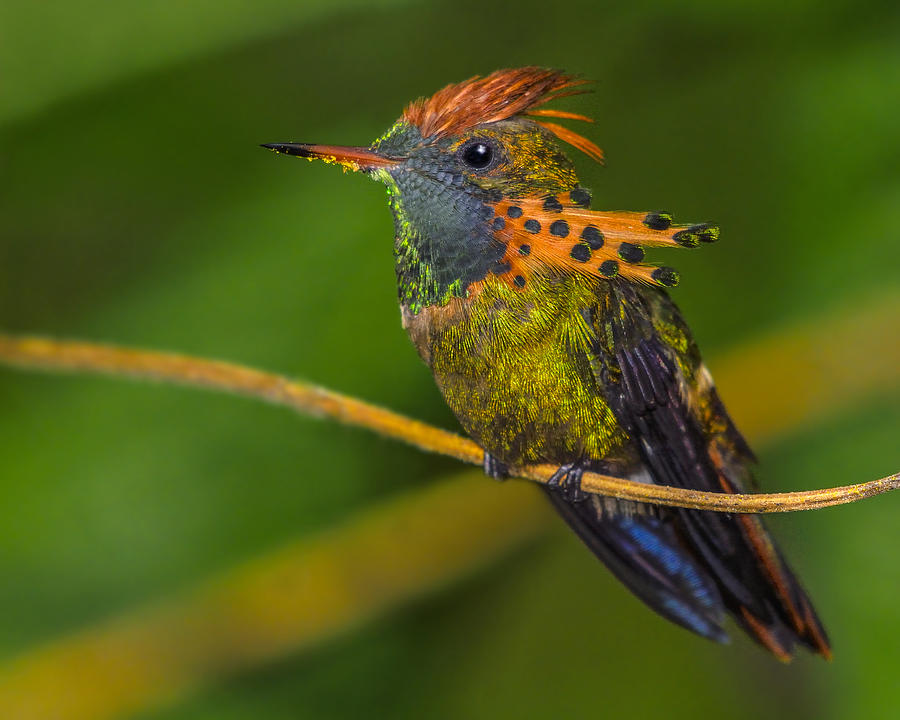Tufted Coquette (Lophornis ornatus) also known as splendid coquette is a South American hummingbird. It is very small and is more similar to an insect than to a bird. They also tend to be quite approachable. In Guyana these unique hummingbirds can be found at the Atta Rainforest Lodge, Iwokrama.
Where Does The Tufted Coquette Live?
They are found in open country, at the edges of humid forests, and thickets, as well as in cultivated areas like gardens, plantations and savannas. Brazil; French Guiana; Guyana; Suriname; Trinidad and Tobago; Venezuela – are some of the countries they are currently found in.
Description Of The Tufted Coquette
The Tufted Coquette is a very small hummingbird – only averaging 6.6 – 8 cm (2.6 – 3.1 inches) in length – including its tail and weighing around 2.3 g (0.08 ounces). It is so tiny that it can easily be confused with a large bee as it moves from flower to flower. Its red beak has a black tip and is short and straight.
- The male has striking black-spotted rufous / orangey-colored feathers that project from the sides of his neck and a rufous / orangey head crest. His back is coppery green with a whitish rump band. His forehead and under plumage are green and the tail is a golden rufous.
- The female doesn’t have the flashy crest and plumes of the male. She is green above, except for the whitish tail band. Her under plumage is rufous-colored, becoming much paler on the abdomen. Her tail is bronze green with a dusky band and whitish feather tips.
- Juvenile males look like females, but the throat is whitish with fine dark spotting; they have a white rump, reddish forehead, and close to maturity, juvenile males show a hint of the future streamers on the neck.
Feeding Habits Of The Tufted Coquette
They primarily feed on nectar taken from a variety of brightly colored, scented small flowers of trees, herbs, shrubs and epiphytes. They favor flowers with the highest sugar content (often red-colored and tubular-shaped) and seek out, and aggressively protect, those areas containing flowers with high energy nectar. They also take some small spiders and insects.
They may also visit local hummingbird feeders for some sugar water, or drink out of bird baths or water fountains where they will either hover and sip water as it runs over the edge; or they will perch on the edge and drink – like all the other birds; however, they only remain still for a short moment.
Did you know?
Males establish feeding territories, where they aggressively chase away other males as well as large insects – such as bumblebees and hawk moths – that want to feed in their territory. They use aerial flights and intimidating displays to defend their territories.
Behavior Of The Tufted Coquette
Tufted Coquette, as other hummingbirds, is able to fly in all directions when feeding on nectar. It may fly forwards, backwards, sideways, upwards and downwards, in order to enter or to leave a flower. The rapid wing beats produce a kind of metallic buzz. When feeding at flowers, its flight is rather slow and deliberate. If threatened, the Tufted Coquette approaches the predator by rapid diving attacks, while it gives high-pitched warning calls. Usually, the female uses this behavior at nest-site against potential intruders. But when it is attacked by larger hummingbird at food source, it weaves away from the predator or leaves the area. Tufted Coquette is sedentary in its range, because flowering trees which provide nectar are available all year round within the tropical regions where it inhabits.
Calls Of The Tufted Coquette
Tufted Coquettes are usually silent, but may give a quiet chik while feeding.
Did you know?
The rapid beating of the wings while hovering produces a buzzing sound, “quite different from that produced by other small hummingbirds”.
Reproduction Of The Tufted Coquette
Breeding season occurs from January to April in Trinidad and from December to March in Guyana. Their nest is usually selected by the female near nectar source. It is a small cup made with fine materials such as fibres and plant down, situated in vegetation, at about two metres above the ground, on a branch. The female usually lays two white eggs. She incubates during two weeks. Young fledge about 20 days after hatching. They are fed by female by regurgitated mixed food including nectar and tiny invertebrates. After leaving the nest, the young are still fed by the female during 18 to 25 days. Young remain at the same place during several days, usually high in trees, and female comes to feed them. Later, when they are able to fly well, the young follow their mother to the feeding areas, in order to learn how to feed themselves.
About Tufted Coquette
The tufted coquette is a very small hummingbird that is more similar to an insect than a bird. They are can be found in Guyana, Venezuela, Trinidad, Brazil etc. They feed on nectar of brightly colored flowers. In Guyana, you can currently find them at the Atta Rainforest Lodge, Iwokrama.
Article References:
- https://www.kesterclarke.net/galleries/birds-of-guyana/hummingbirds/tufted-coquette/
- https://www.hbw.com/species/tufted-coquette-lophornis-ornatus
- https://neotropical.birds.cornell.edu/Species-Account/nb/species/tufcoq1/behavior
- https://www.beautyofbirds.com/tuftedcoquettes.html
- Main Image: Tufted Coquette is a photograph by Tony Beck which was uploaded on March 27th, 2016, https://fineartamerica.com/featured/tufted-coquette-tony-beck.html







